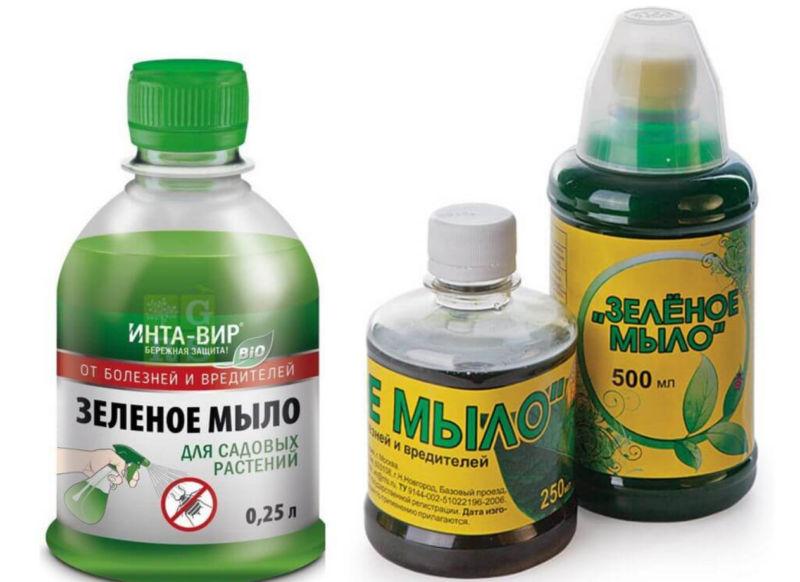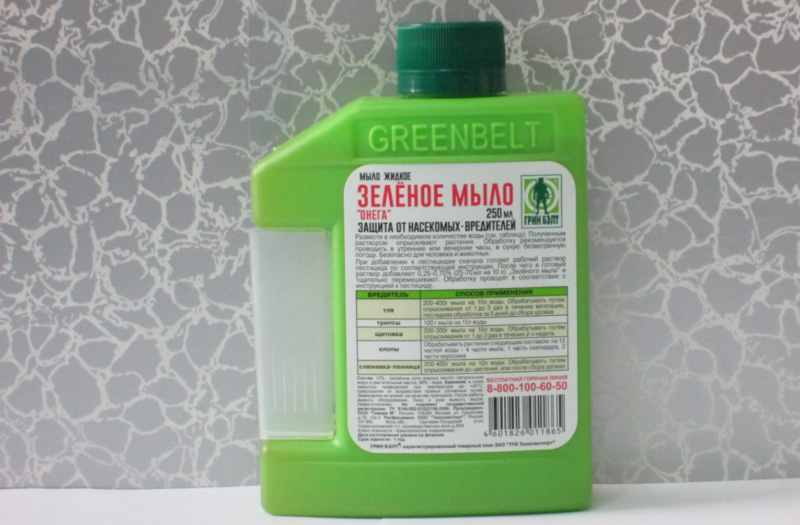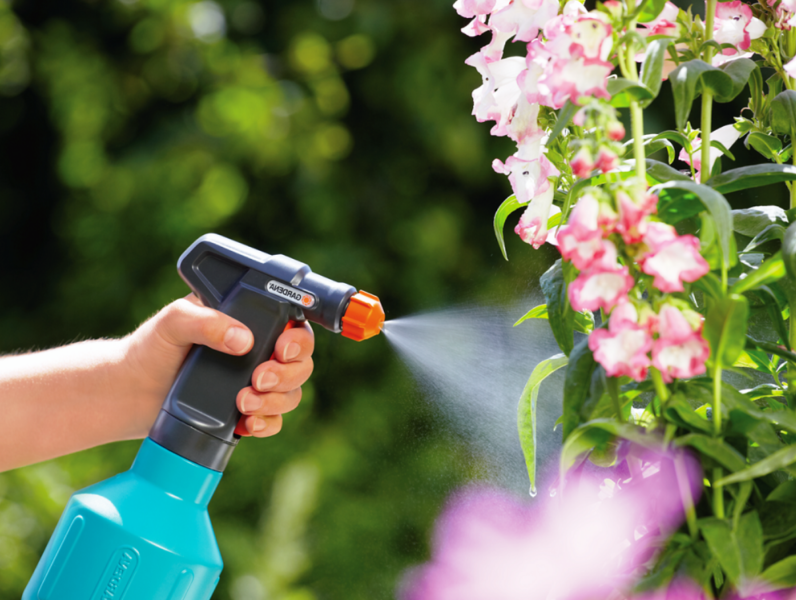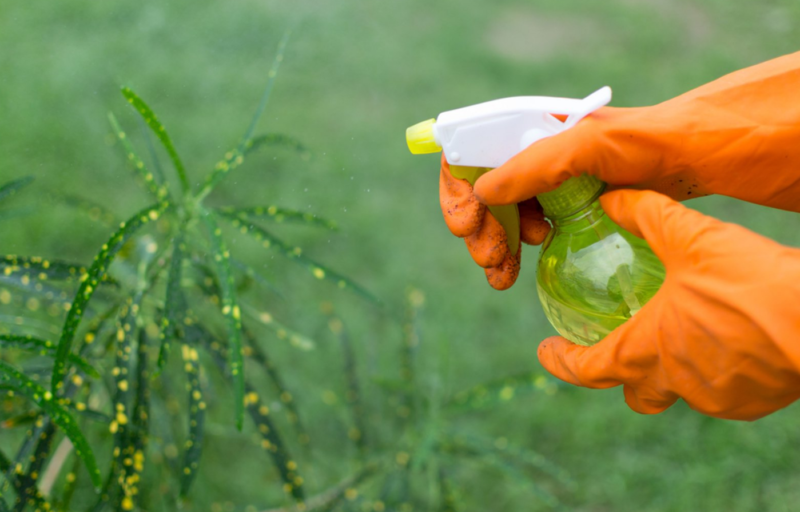Green soap is a natural product with a disinfecting effect, which is successfully used by gardeners and gardeners for the prevention and treatment of plant diseases, pest control. The product is not dangerous for pollinating insects, humans and animals. It is also used as a mono-preparation in combination with various components, increasing the processing efficiency.
Material Content:
The composition of green soap
This product has been known in Russia since 1670. The drug acquired the name “green soap” from the time when hemp oil was used to create it. Now this tool is a viscous consistency of greenish or light brown in color. Natural indigo dyes, aniline blue and similar compounds are used to provide the desired shade to the liquid. The substance is obtained by cooking fats with potassium carbonate, which provides a lot of soapiness (in this soap contains sodium carbonate (soda).
Ingredients Used:
- animal fats (mutton or beef);
- vegetable oils;
- potassium carbonate;
- water.
Among the components are completely no preservatives. All components of the Green (potassium) soap have a biodegradable basis, do not harm the soil and water bodies. The drug is recognized as an environmentally friendly product in accordance with the Decree of the EEC 2092/91, therefore, it can be used in ecological farming.
If flaxseed oil is present in Green Soap, it can be used in cold weather, as the solution has the ability to not freeze at 0 ° C. In the summer heat, it is preferable to use soap with olive and palm oils.
Nevertheless, Green Soap solutions have an alkaline reaction, and excess liquor can have a negative effect on animals and people, therefore it is necessary to strictly observe the concentration of the drug.
Benefits for plants
Green soap has a lot of advantages, the main of which is the versatility of the product - the ability to use for all types of plants not only in open ground, but also indoors.
Preventive spraying with a solution having bactericidal properties increases the resistance of crops to adverse environmental factors, protects against diseases and pests.
The resulting protective film on the treated surface delays the evaporation of moisture, thereby maintaining water balance in a hot dry period.
Plants with soft leaves easily tolerate a viscous substance, and if necessary, treatment of diseases Green soap destroys the dense water-repellent layer of the cuticle of the leaf. Due to the stickiness of the solution, the composition of the drug lasts longer on the surface of vegetative organs. Soap softens the cuticle wax, improving the penetration of the drug inside.
How does the remedy affect pests
Green soap has insecticidal properties, acting on the respiratory system of the parasite, envelops the individual with a dense "cocoon" of foamy substance, the insect is immobilized and dies.
The viscosity of the solution prevents the spread of sucking pests, affecting adults, destroying their larvae.
At the same time, it does not have a negative effect on bees, ladybugs, lacewings and other helpers useful to plants.
Instructions for use
To achieve the effect, individual dosages for each task are required.
Prevention
Plants are sprayed with a clean solution of Green Soap at the rate of 200-400 ml per 10 liters of water. Processing can be arranged throughout the vegetative period. A film is formed that blocks access to the stems and leaves of pathogenic bacteria, fungal spores and sucking pests.
Soap does not have any effect on soil microorganisms, therefore it is better to spray root crops, seeds and tubers before planting.
Insect control
Processing is carried out by a directed stream of the agent into the accumulation of parasites, since the Green Soap acts more reliably in contact with the insect shell.
To get rid of aphids, slobber-pennies, you need 400 ml of soap per bucket of water, thrips - 100 ml / 10 l. You can spray all varieties of plants in open ground and enclosed spaces up to 3 times during the season. Recent events are recommended to be carried out 5 days before the harvest.
From the scabs - 300 ml per bucket, use the solution 1-3 times in 2 weeks.
To destroy more persistent pests, such as bugs, it is necessary to add kerosene to the solution, since it will enhance the action of the soap composition. Dilute 250 ml of soap in 1 liter of boiling water, cool to +50 ° C, add 2 liters of kerosene with a thin stream with constant stirring. The resulting emulsion has the consistency of sour cream. For spraying with a sprayer, it is combined with water (1:10).
The same mixture can be used in early spring or late autumn in the garden for the destruction of individuals wintering on branches and under the bark.
The spider mite dies from treatment with a 3% soap solution with the addition of copper sulfate (2 g), malathion (2 g) and nicotine sulfate (2 g) per 10 l of water. Pesticides are diluted separately in a liquid, then introduced into a soap composition with a thin stream, stirring until completely dissolved.
Green soap from pests goes well with homemade infusions and decoctions of herbs, garlic, tobacco dust, ash. For example, a solution of 1.5 kg of ash and 30 ml of soap, diluted in a bucket of water, saves the planting of cabbage, cucumbers and nightshade crops from moths and butterfly larvae.
When mixed with insecticides, a composition of 40-100 ml of soap per 10 liters of liquid is prepared, adding the required amount of chemical according to the instructions.
Disease treatment
The mechanism of action of Green Soap is based on the creation of an airtight film on the surface of the plant. Without access to oxygen, the entire pathogenic microflora perishes.
Using fungicides with a soap component, the spread of late blight, powdery mildew, scab, and rust can be prevented.
Help with mildew will help 1% soap solution with the addition of 1% colloidal sulfur. Spray in sunny weather at +20 ° C until dripping drops appear.
Sooty fungus is washed off the plant with 2% Green soap, then an additional spraying with a copper-soap composition is carried out, adding 20 g of copper sulfate to 10 l of a 2% soap solution.
Home flowers
For indoor plants, Green soap is the best option, especially if there is an aquarium in the house. For fish, the product is absolutely safe, unlike other pesticides.
Soapy solution prepared from 1 tbsp. l soap and 1 liter of water, get rid of pests and diseases, additionally wrapping the flower in a plastic bag until the composition dries. It is not necessary to wash off the film - it also protects the plants from dehydration.
Using a soap solution with added pesticides, strictly observe the concentration of chemicals. Exceeding doses can adversely affect both the flowers and the health of humans and animals.
Before preparing the solution, the container with the Green soap must be shaken vigorously, since at the bottom of the bottle it is possible to find a precipitate that does not affect the effectiveness of the product. The substance is highly soluble in both cold and hot water with vigorous stirring. After freezing, retains its characteristic properties.
Is the drug dangerous for people? Precautions
Green soap for indoor plants is a low-toxic substance. The vapor of the product, even in the sun, is not harmful to health.
- And still it is necessary to protect hands with gloves.
- In case of contact with the skin, rinse off the preparation under running water, for allergy sufferers you can apply a dressing soaked with 5% vinegar on top.
- In case of contact with eyes, rinse with plenty of water, then with 2% boric acid solution and instill albucid.
- If the product has entered the body, you should rinse the stomach, drink activated charcoal and consult a doctor.
In the future, containers for soap solution cannot become dishes for cooking.
How to store green soap
It is recommended to keep the substance in a plastic sealed container at a temperature of +15 ° C to +40 ° C. Freezing is allowed. Shelf life - up to 2 years. Do not use aluminum or galvanized containers.
According to the instructions for use, a soap solution from parasites is used throughout the growing season. Unlike other insecticides, after processing with soapy water, you can harvest crops for storage already on day 5.

















